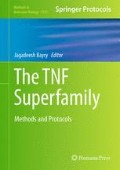Abstract
LIGHT (TNFSF14, CD258) is a member of the tumor necrosis factor (TNF) ligand superfamily, which is involved in innate and adaptive immune responses as well as in regulation of cell survival and proliferation. LIGHT forms a membrane-anchored homotrimeric complex on the cell surface and is often processed as a soluble protein. In this study, we established an effective strategy for producing bioactive soluble forms of human LIGHT (s-hLIGHT), which is an extracellular region (Ile84-Val240) of human LIGHT (hLIGHT), and soluble forms of mouse LIGHT (s-mLIGHT), which is an extracellular region (Asp72-Val239) of mouse LIGHT (mLIGHT). To enhance the refolding of s-hLIGHT from inclusion bodies in Escherichia coli, we added l-cysteine to the denaturation buffer, which significantly improved the refolding efficiency of s-hLIGHT. However, there was little information available about the biological activity of mLIGHT in the literature because of the difficulty in producing bioactive s-mLIGHT. We produced trimeric s-mLIGHT by fusing s-mLIGHT with a trimerization domain termed “foldon” from bacteriophage T4 fibritin (Foldon-mLIGHT). We further demonstrated that Foldon-mLIGHT inhibited the growth of mouse carcinoma cells at the picomolar range, indicating that trimerization of s-mLIGHT is essential for its biological activity.
Access this chapter
Tax calculation will be finalised at checkout
Purchases are for personal use only
References
Mauri DN, Ebner R, Montgomer RI, Kochel KD, Cheung TC, Yu GL et al (1998) LIGHT, a new member of the TNF superfamily, and lymphotoxin alpha are ligands for herpesvirus entry mediator. Immunity 8:21–30
Tamada K, Shimozaki K, Chapoval AI, Zhu G, Sica G, Flies D et al (2000) Modulation of T-cell-mediated immunity in tumor and graft-versus-host-disease models through the LIGHT co-stimulatory pathway. Nat Med 6:283–289
Morel Y, Truneh A, Sweet RW, Olive D, Costello RT (2001) The TNF superfamily members LIGHT and CD154 (CD40 ligand) costimulate induction of dendritic cell maturation and elicit specific CTL activity. J Immunol 167:2479–2486
Shaikh RB, Santee S, Granger SW, Butrovich K, Cheung T, Kronenberg M et al (2001) Constitutive expression of LIGHT on T cells leads to lymphocyte activation, inflammation, and tissue destruction. J Immunol 167:6330–6337
Browning JL, Sizing ID, Lawton P, Bourdon PR, Rennert PD, Majeau GR et al (1997) Characterization of lymphotoxin-alpha beta complexes on the surface of mouse lymphocytes. J Immunol 159:3288–3298
Harrop JA, McDonnell PC, Brigham-Burke M, Lyn SD, Minton J, Tan KB et al (1998) Herpesvirus entry mediator ligand (HVEM-L), a novel ligand for HVEM/TR2, stimulates proliferation of T cells and inhibits HT29 cell growth. J Biol Chem 273:27548–27556
Granger SW, Butrovich KD, Houshmand P, Edwards WR, Ware CF (2001) Genomic characterization of LIGHT reveals linkage to an immune response locus on chromosome 19p13.3 and distinct isoforms generated by alternate splicing or proteolysis. J Immunol 167:5122–5128
Rooney IA, Butrovich KD, Glass AA, Borboroglu S, Benedict CA, Whitbeck JC et al (2000) The lymphotoxin-β receptor is necessary and sufficient for LIGHT-mediated apoptosis of tumor cells. J Biol Chem 275:14307–14315
Chen MC, Hwang MJ, Chou YC, Chen WH, Cheng G, Nakano H et al (2003) The role of apoptosis signal-regulating kinase 1 in lymphotoxin-beta receptor-mediated cell death. J Biol Chem 278:16073–16081
Hikichi Y, Matsui H, Tsuji I, Nishi K, Yamada Y, Shintani Y et al (2001) LIGHT, a member of the TNF superfamily, induces morphological changes and delays proliferation in the human rhabdomyosarcoma cell line RD. Biochem Biophys Res Commun 289:670–677
Matsui H, Hikichi Y, Tsuji I, Yamada T, Shintani Y (2002) LIGHT, a member of the tumor necrosis factor ligand superfamily, prevents tumor necrosis factor-α-mediated human primary hepatocyte apoptosis, but not Fas-mediated apoptosis. J Biol Chem 277:50054–50061
Hehlgans T, Mannel DN (2001) Recombinant, soluble LIGHT (HVEM ligand) induces increased IL-8 secretion and growth arrest in A375 melanoma cells. J Interferon Cytokine Res 21:333–338
Tsuji I, Matsui H, Ito T, Kurokawa T, Shintani Y (2011) l-Cysteine-enhanced renaturation of bioactive soluble TNF ligand family member LIGHT from inclusion bodies in Escherichia coli. Protein Expr Purif 80:239–245
Ito T, Iwamoto K, Tsuji I, Tsubouchi H, Omae H, Sato T et al (2011) Trimerization of murine TNF ligand family member LIGHT increases the cytotoxic activity against the FM3A mammary carcinoma cell line. Appl Microbiol Biotechnol 90:1691–1699
Meier S, Guthe S, Kiefhaber T, Grzesiek S (2004) Foldon, the natural trimerization domain of T4 fibritin, dissociates into a monomeric A-state form containing a stable beta-hairpin: atomic details of trimer dissociation and local beta-hairpin stability from residual dipolar couplings. J Mol Biol 344:1051–1069
Del Rio M-L, Jones ND, Buhler L, Norris P, Shintani Y, Ware CF et al (2012) Selective blockade of HVEM-BTLA pathway ameliorates acute graft vs host disease. J Immunol 188:4885–4896
Laemmli UK (1970) Cleavage of structural proteins during the assembly of the head of bacteriophage T4. Nature 227:680–685
Acknowledgments
The authors thank Drs. Ito T, Matsui H, Kurokawa T, and Taniyama Y for their kind guidance, constructive discussions, and encouragement throughout this work.
Author information
Authors and Affiliations
Corresponding author
Editor information
Editors and Affiliations
Rights and permissions
Copyright information
© 2014 Springer Science+Business Media New York
About this protocol
Cite this protocol
Tsuji, I., Iwamoto, K., Shintani, Y. (2014). Effective Expression and Purification of Bioactive Recombinant Soluble LIGHT. In: Bayry, J. (eds) The TNF Superfamily. Methods in Molecular Biology, vol 1155. Humana Press, New York, NY. https://doi.org/10.1007/978-1-4939-0669-7_17
Download citation
DOI: https://doi.org/10.1007/978-1-4939-0669-7_17
Published:
Publisher Name: Humana Press, New York, NY
Print ISBN: 978-1-4939-0668-0
Online ISBN: 978-1-4939-0669-7
eBook Packages: Springer Protocols

